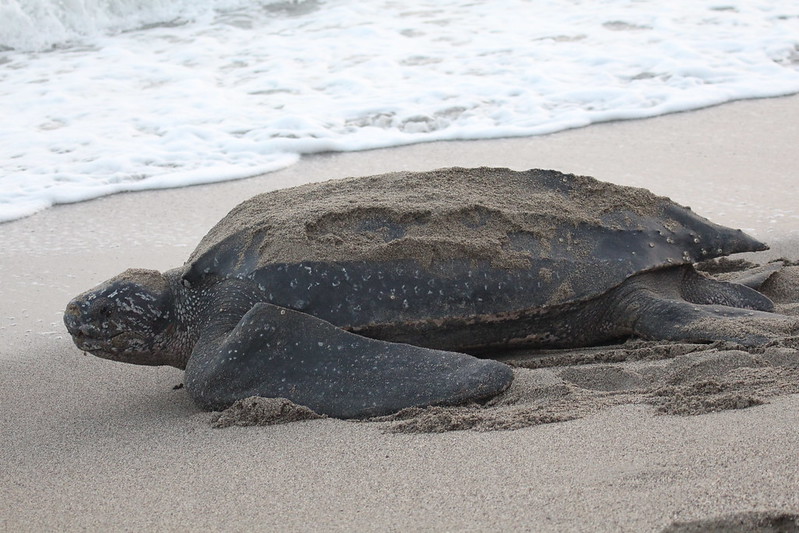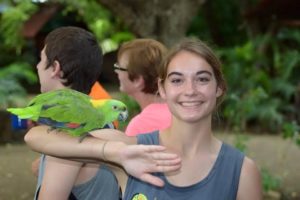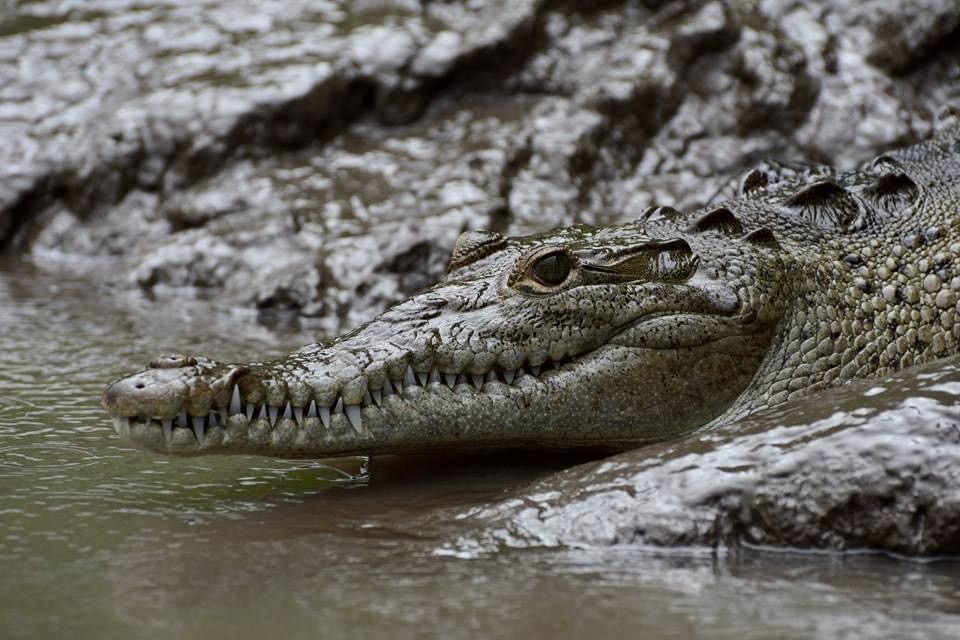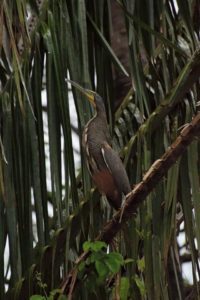
A leatherback sea turtle. Image credit: Alastair Rae
By Elise Ertl, University of Wisconsin-Superior
Our student blogger intern, Elise, shares a story about her experience a few years ago helping leatherback sea turtles in Costa Rica. An estimated 34,000 to 36,000 nesting females are now left worldwide, compared to 115,000 in 1980. Elise traveled with her mother, who is a biology teacher in north-central Wisconsin. We hope you enjoy this virtual trip to the tropics!
The air is hot and humid. The summer breeze smells of sea salt and wet sand, something the trees experience all the time. How luxurious for the trees — moisture-laden air, golden, sunny rays and fertilized ground. Their trunks are weathered, yet untouched and strong. The soil materializes to a dark, moist brown that I could imagine seeping through my toes as my feet begin to sink.
I envy the Costa Ricans their way of life. They seem happy, carefree and to enjoy living a simple life. One of their sayings, “Pura Vida,” means pure life, better translated to, “don’t take life so seriously,” or, “take it easy.” I wish life could always be thought of in this way. I want to relax and take life slowly, one step at a time. That’s not the kind of life that I am used to, but is something for which I deeply long.
Something else I deeply cherish is Costa Ricans’ regard for nature. In Costa Rica, harming or killing any animal is illegal, including the minute mosquito or spider. I think of it as a recognition of the delicate balance of the ecosystem that can be found in the rainforests of their country. As one Costa Rican explained, “We are just one small part of nature. Nature is our home. We must respect every living creature as we respect ourselves.” Every hour I spend learning and exploring the grounds of Costa Rica, the more I fall in love with the people and their values.

Elise Ertl and friend. Submitted image.
I am on my way to Pacaure Reserve, a small research center for leatherback sea turtles, the largest species of sea turtle. I am sitting in the back of a van whipping down a long winding road. I pull out my water bottle and take a sip of my warm water to try and ease the nausea of motion sickness. Don’t throw up. Don’t throw up.
I wish my spinning head would still. I am aware that alongside the road waterfalls flow over bright green vines, clay and rock, but my head blends it all together.
We finally veer off the never-ending bending road, and I never thought I would be so happy to feel the bumpiness of a gravel surface. Any road is better than the previous one! The spinning slowly subsides the more I focus on the view outside my window. This area is not like what I had seen so far but rather dry and could probably use a good day of rain. The van pulls up alongside a river where two men wait for us with their two boats. Normally, I would not hop in a boat with a strange man, but these men smile, laugh, and obviously care about my safety as they hand me a life jacket.
The boats are nothing fancy, made of tin and painted dark green with metal seats. Knowing the boats are a bit tipsy, the man reaches for my hand and I reluctantly take his offer. I tumble into the rocky boat, catching myself and scorching my hand on a hot metal seat. My skin turns bright red and feels like it is on fire. I am an inch away from sticking my hand in the water to find relief when I feel my wrist snatched.

A Costa Rican crocodile. Image by Craig Hemsath.
“No, no, no,” the man says, looking at me with wide eyes and gaping mouth. “Keep your hands inside the boat at all times. There are crocodiles everywhere.”
An alarm goes off in my head. “There’s crocodiles everywhere!?” I say as my expression begins to match the man’s. I look around and sure enough, every 10 feet along the river edge, crocodiles lurk. Dark brown, yellow-eyed crocodiles and their babies await their next meal. “Thank you,” I say as he lets go of my wrist, and we both sigh in relief.
The boat ride is stunning, and I even grow to like the crocodiles soaking up the sun on the sand pits of the water’s edge. Birds whose songs I do not recognize are singing louder and louder in a call and response to one another. I see one peculiar black, skinny beak sticking up from the water, moving from one area to the next. The man driving my boat is a native, and I ask him what that animal with the long sharp beak is called.

An anhinga. Image by Craig Hemsath.
He responds, “That is an Anhinga. They eat crocodiles.” Alarmed at first, I find comfort in the thought that this small but mighty bird is my protector against the crocodiles.
The boats stop by a short sand pathway that leads to our final destination, the Pacuare Reserve. As we walk up the shore with our gear on our backs, the first thing we notice is a small brown building with a concrete patio out front. People are gathered at the picnic tables, eating a meal of rice, black beans and fried plantains. What we don’t know is that meal would become the same one we would eat for the next two weeks. Everyone gathered introduces themselves as the researchers of the project and the ones who will be helping us with our sea turtle research. They all look fresh out of college and happy to be spending their time on this reserve.
Soon after meeting the researchers, the owner of the reserve shows us where we will be staying. Long, tan and skinny yurts reminiscent of a Girl Scout camp stand before me, except this time, the spiders will be enjoying their stay with us, since we cannot kill them here. To avoid ants and other animals coming into the yurts, we are told to make sure there is absolutely no food in our bags, and to come back to the concrete patio as soon as we are ready. We are starting our training right away.
Down at the patio, the researchers split us into groups and take us down to the beach. On our way, I notice signs written in Spanish lining the rocky trail, showing pictures of the different types of Tortugas (turtles) that come to nest on this beach. We are here to document the number of leatherback sea turtles that come to nest, measure their length and width, collect their eggs and relocate them to safe place on the beach where poachers and predators cannot find them.
Our training begins with a group activity to build the best, and most accurately sized, leatherback sand sea turtle. We start sculpting turtles out of the moist sand, having no idea how big these turtles really are. Our sand modeling done, the researchers teach us how to properly measure a turtle, but note that our turtles are only three feet long, when the average leather back turtle is six- to seven-and-a-half-feet long. My group can’t imagine a turtle longer than an arm’s length.
The instructors teach us everything we need to know to assist the researchers. As we learn, I realize how ingenious these creatures are. Leatherbacks implement a defense against predators by laying different-sized eggs. The first 100 or so eggs are fertilized and about the size of a billiard ball, while the next 30 to 50 eggs are unfertilized and ping-pong-ball-sized. By placing fake eggs on top, the mother leatherback increases her young’s chance of survival.
The researchers tell us we are now ready to begin our first night shift out of 14, but none of us realizes how unprepared we are for what we are about to witness.
Night after night, we scour the beaches, hoping our group will be the next to help the half-ton, egg-bearing mother leatherback sea turtle deliver her young to safety. As the days go on, the outlook becomes more and more grim as we have not seen any turtles, but both of the other groups had seen and helped one, if not two, already.
It’s my group’s final night shift at the reserve. After walking down the beach, I gaze over the darkened water, only seeing as far as the moonlight allows. The sound of the ocean waves swaying so gracefully makes me feel as if I could close my eyes and lie down to drift away. Taking in a deep breath of fresh, warm air, I almost don’t care if I see a turtle or not. As magnificent as it would be, I have so much magnificence already in front of me — a vast ocean joined by never-ending rainforest — and I am standing on the centerpiece. Bioluminescent algae make the water glow in the dark and the sands sparkle in every direction. In the night, I hear waves, and I feel wind. I even smell the alarming and musky scent of a jaguar.
Life doesn’t stop at night. When the Earth falls silent and the lights turn off, the creatures of the night awake. Not monsters and ghosts, but hidden gems that gleam in daylight’s absence. A new world is brought alive without the sun’s perpetual shadow.
Our group leader, Laura, interrupts my wandering thoughts with a hushed voice telling us to crouch down. When my eyes settle, I see a massive creature emerging from the many-thousand-mile trip she endured across the ocean. The group falls silent in awe and disbelief. Two front flippers rise from the ground in tremendous effort to pull herself through the sand and up toward the trees lining the beach edge. Ten seconds between each pull forward and nine seconds of heavy, laborious breathing. I can hear the air being inhaled through her nostrils and exhaled with every task, leading to her utter exhaustion.
She reaches the top of the beach and turns her body to face the ocean. Using her two back flippers, she forms a scoop and begins to dig and dig until her flippers can reach no farther, and falls into a trance to begin the laying process.
We slowly move closer to the mother sea turtle. The nearer I get, the more I realize she’s been here longer than any of us have been alive and her ancestors longer than humans have been on Earth. Sea turtles truly are dinosaurs of the sea.
We use a red light to not awaken or disturb her. If she were to see white light, she would think it is daytime and descend back to the water to lay her eggs another time.
We take the measurements of her five-ridged shell. Her length measures six feet, seven inches. Her width from front flipper to front flipper measures six feet, ten inches. We place a large, sturdy bag into the dug-out hole behind the mother turtle just before she begins to lay, and we count. One, two, three, four, one after another, billiard-ball-sized eggs stack slowly filling up toward the top.
We count 83 eggs and then she lays 30 unfertilized, golf-ball-sized eggs over her children as a blanket of disguise against potential predators. The temperature of the upcoming days will determine the sex of the baby turtles. If temperatures are warm, females will be born, and if temperatures are cooler, the turtles will be male.
After around 45 minutes, we close the bag and allow her to fill the hole back up with sand. She soon departs back down toward the water. I hear her take one last breath, this time sounding of relief, and watch her fade away to spend her life in the mysterious sea.
I realize I have just experienced a small slice of her life, and I am forever grateful to have been a part of something so special.
We remove the eggs from the original hole dug by the mother and relocate them to one of our own making with the exact same measurements of 28 inches deep, which we dug in a safer spot. We place the eggs bottom to top, largest to smallest.
I can’t help but think of the long, dangerous journey these baby turtles will embark on once they hatch, and hope they live to experience a life like their mother. I hope these turtles return to this same beach at the Pacuare Reserve to lay their eggs. I hope another young person like myself will get share the chillingly beautiful experience of hearing a mother sea turtle’s breath, and I hope they will cherish being a part of such a pivotal moment in her life. Maybe one day, my child and one of this mother sea turtle’s children will meet on this very same beach, and share the same experience we had today.
As we head back to the reserve, I’m overwhelmed to have witnessed something so grand and so beautiful. I want to stay here forever and feel this again and again like it was the first time, but tonight is my last night and tomorrow, we leave.
The people here are immersed in these surroundings every day. They live in nature, nature doesn’t live around them. They take moments to slow down and remember what is truly important in life and what is worth valuing, such as the endangered leatherback sea turtles. That is now something I strive for day after day, and I hope one day, I too will find myself saying “Pura Vida” on the sunny, tan beaches of Costa Rica.


